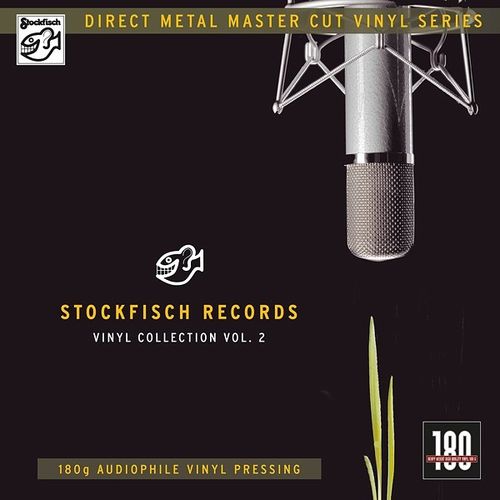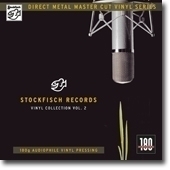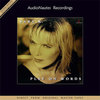Stockfisch - SFR 357.8009.1 - 180 Gram Virgin Vinyl
Mastering by Hans-Jorg Maucksch at Pauler Acoustics - Pressed in Germany
Enjoyable Listening, Audiophile Sound! , A great introduction to Stockfisch artists
It is astonishing and pleasing: in the face of downloads and MP3 there is still a market demand for the vinyl LP, which is already 60 years old. Stockfisch, therefore, releases the second volume of their Vinyl Collection containing ten tracks featuring known and new Stockfish artists.
Stockfisch compiled the tracks for Volume 2 of the Vinyl Collection following the established criteria of the 'Closer To the Music' compilations. On one hand they want to offer samples of current Stockfisch albums, on the other hand they would like to give a sneak peek on their future recordings.
For the first time available on vinyl are one of Allan Taylor's songs from the Porsche/Burmester session, Ewen Carruthers "That Train" - paying homage to the English singer/songwriter who departed in 2010, Paul O'Brien - the Irish melancholic songwriter from Canada, the Australian folk-duo Carl & Parissa, and David Munyon's new album Pretty Blue.
The unreleased song from Katja Maria Werker's first Stockfisch album, "Mitten Im Sturm", the guitar piece played by the virtuoso Ralf Illenberger, who had recorded with Stockfisch Records in the '70s, and lives in the U.S.A. today, furthermore a wonderful song from Paul Stephenson's third album, , are among those Stockfisch is excited to introduce.
The label is also glad to present an unreleased piece with the outstanding guitarist Chris Jones who passed away in 2005. During a studio session in 2001, a remarkable instrument, a Dreadnought, made by Moritz C. Sattler (Manzanita), caught Chris' eyes. He couldn't stop improvising with his guitar - and happily Stockfisch let the tape keep running.
Pre-mastering by Hans-Jorg Maucksch
DMM Disc Cutting by Hendrik Pauler
Mastering Monitors: B&W Nautilus 801 D
Selections:
Side A
1. Tief Im Innern - Katja Maria Werker
2. That Train - Ewen Carruthers
3. Frogs - Ralf Illenberger
4. Paul O'Brien - He Can Dance
5. Westwinds - McKinley Black
Side B
1. Let the Music Flow - Allan Taylor
2. Into the Light - Carl Cleves & Parissa Bouas
3. Improvisation - Chris Jones
4. Carolina Song - David Munyon
5. Now So Far - Paul Stephenson
We at Pauler Acoustics have developed a new record format (DMM-CD), which contains only the desired sound and typical tonal qualities of a vinyl record. Our method is based on the fact that the "vinyl sound" in the first place is created as a result of transferring an analogue or digital master on to a copper-coated stainless steel disk (Direct Metal Mastering).
The crucial step to DMM-CD:
Our Neumann VMS-82 cutting lathe functions as the original record player, because after the cutting process, we leave the copper master on the lathe held firmly by vacuum suction. This way the disc has no vertical or lateral movement, which would affect the tracking of the pick-up stylus.
Using the best possible components, we play back the signal from the freshly cut groove. The components used are: an EMT TSD-15 Pick-up, a factory built special version of EMT’s legendary Broadcast TONDOSE TSD-15 and incorporates a diamond made from a square natural rod. This diamond is refined with a highly sophisticated shape with multiple facets resulting in a frontal parabola measuring 17 x 25 µ. This diamond quality secures not only very little distortion, but also very low FIM (Frequency Intermodulation Distortion). Moreover we decided to use an EMT 997 pick up arm and a top of the range EMT JPA66 valve pre-amplifier. With critical listening tests, this combination has proven to us to be the optimal chain when it comes to obtaining a sound as close as possible to the master.
The output of the JPA66 cutting curve equalizer transfers the analog signal to the A/D converter, a "Meitner EMM Labs adc 8 MK IV". This is still regarded as a reference for the best possible conversion to the 1-bit Direct Stream Digital format. The DSD signal is then recorded at a sampling rate of 2.8224 MHz on to our SADiE DSD8 mastering system. Later, on the finished Hybrid-SACD, you will find this true 1-bit DSD layer and also a generated CD format at 16-bit/44,1kHz.
To enhance the tonal quality of the DMM transfer for the DMM-CD, we cut the music programme at 45 rpm, and basically only use the area between the two zero crossings of the cartridge arm. This is the area where the geometry of the pick-up arm is optimal. However, this decision costs a few copper blanks more, as it reduces the running time per side as opposed to the pressed vinyl LP.
With this new sophisticated process, a new digital recording media (DMM-CD) has emerged retaining the original sound of a Vinyl-LP but without the unwanted side effects. The DMM-CD/SACD gives you the direct sound of the DMM Copper cut - without having to go through the stages of pressing a record.
Direct Metal Mastering is a quality term for authentic records dubbing. We have deliberately opted for the then current state of the template cutting technology - just before the CD 1982 their (alleged) triumphant launched.
The DMM copper master knows no pre-echoes and no loss of high frequencies, provides longer seasons and has much less noise than a cut in nitro lacquer film "Urschallplatte". A reduced electroplating DMM dies in the pressing plant also benefits the quality and the price.
Hendrik Pauler is home Pauler Acoustics / stockfish specializes in the demanding process of records dubbing. Here the stockfish vinyl productions are not only cut, but also numerous other labels use the long-standing experience in Disc Cutting Pauler Acoustics. In Northeim the Direct Metal Mastering system VMS 82 of the Berlin company NEUMANN is used for.
DMM Cutting-Head SX84
How does a DMM matrices-cutting process in detail?
Before the actual cut the dubbing parameters must be determined in a trial run. Depending on the length of the program, from its frequency response - especially in the bass range, depending on the phase correlation and in particular determines it is by the dynamics of the stereo signal, define important values for VMS-82: the feed rate of the diamond stylus, the groove depth and the dubbing level.
Today, the advantages of the so-called Füllschrift method are used for the record section. If one were to renounce this technique, the Stichelvorschub would be constant and the groove spacing would have on the maximum deflection, so the loudest part addressed in the program somewhere. So much space would presented on the plate and the entire duration of one side would be extremely short.
Pauler Acoustics - cutting studio
The cutting head, the music must for Füllschrift process first, so to speak "learn" before he can cut into the copper plate. For this, the signal is the cutting system leaked twice in quick succession. The cue tells the system how much the displacement will be in the next groove. The second, time-delayed signal is then sent to the cutting box SX-84. The groove pitch will therefore be less great when quieter program than on loud signals. It dynamically adapts to the music parameters.
The test run will take place in real time. The cutting system is started and is running - though still without the copper matrix. When the sample program rehearsed for a page found a sensible and efficient use of space, the actual cut can begin.
DMM Cutting Lathe VMS 82
The stainless steel carrier of 0.1 mm provided with a microcrystalline layer of copper is placed on the plate of the VMS-82. A vacuum pump draws in the blank flat on the cutting plate firmly. The diamond is lowered and cuts the subsequent lead-in groove of the record. Now the music player device is started. The modulation start is recognized by the cutting system and when music is played, the automatic FAST switched to the normal Füllschrift feed. The diamond cuts now in copper the record groove exactly as it will enable even later in the pressed vinyl record the stylus in the correct analog vibrations.
After the last track of Cutting Engineer on the groove pitch in the spiral form of the escape groove. Subsequently, the cutting can automatically moves to the copper center and Raut there with extremely fine grooves on the surface to which the label will be glued later during the pressing process. At the end of the cutting process, it is still personal: In order for the die in the pressing plant can be clearly assigned, scratches on the disc Cutting Engineer catalog number in the free area of the escape groove and additionally records with his initials. This identifier can find the listener a record later on closer inspection.










